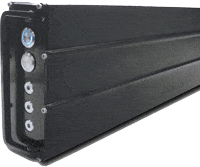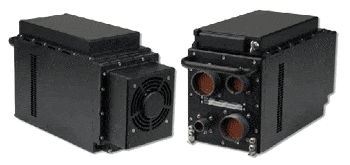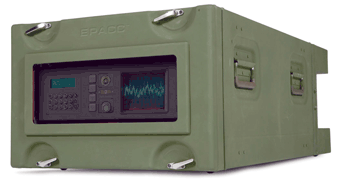Mitsubishi Adds LED-Based Cube to Display Wall Line-up
Mitsubishi Digital Electronics America’s Presentation Products Division has expanded its SeventySeries display wall line with the SeventySeries: LED, an LED-based, rear-projection display wall cube designed specifically for control and command rooms for government, traffic and utility facilities, and network operations centers.
Mitsubishi’s latest LED light source DLP® engine incorporates the company’s Smart Seven Technology and other features that use next-generation technology to provide better reliability and brightness.
Applying Mitsubishi’s control room expertise to new applications, its LED engines offer:
- Pumpless Design: Keeping LEDs cool is critical. Some manufacturers use a pump-driven water cooling system which can lead to mechanical difficulties. Mitsubishi’s SeventySeries: LED displays cool its system with unique heat pipe technology and a 100K-hour cooling fan to help ensure reliability and reduced maintenance.
- LED-Calibrated Automatic Brightness and Color: Mitsubishi’s new SeventySeries: LED engine uses Mitsubishi’s automatic color control to ensure optimal brightness and color uniformity across the wall. This new generation color space control is optimized specifically for LED illumination sources, enabling ideal image quality throughout the display’s lifetime.
- Mitsubishi uses a proprietary power driver for its LED, allowing three power modes: bright, normal and ECO. ECO mode provides optimal power consumption and increases the lifetime of the LED.
- Easy Upgradeability: Mitsubishi’s SeventySeries: LED engine is compatible with all Mitsubishi SeventySeries cabinets and screens for an easy and cost-effective upgrade with minimal disruption. Users simply replace the optical engine instead of purchasing a whole new cube cabinet or screen. Source: Mitsubishi Digital Electronics America
Liquid Submersion Blade Server Addresses Data Center Challenges

Hardcore’s® Core Coolant™ is 1,350 times better than air at heat removal by volume. Not only does this help cool components better, Liquid Blade technology increases compute density because far less space is required between components with liquid cooling than air and much smaller chassis sizes are possible. With all the heat being rejected though liquid, there is no longer a need for fans on the rack level. With little heat escaping into the datacenter, the need for air conditioning and air moving equipment is minimized. The net result is a much smaller physical and carbon footprint for the datacenter. As an added benefit, no need for special fire protection systems to cover the servers. This because all of the blade components are submerged so there is no oxygen exposure. Without oxygen there is no potential for sustainable fire.
Source: Hardcore Computer
New Cooling Technology Materializing the High Brightness Compact Projector
For the competition in the projector market, a compact and lightweight body becomes one of the important factors for selection, as well as high brightness and high resolution, for expanding the mobile use of projectors. However, the high brightness factor has a reciprocal relationship with the factor of a compact and lightweight body, since a high power lamp is generally required to achieve high brightness and then a large-sized cooling system is required for the high power lamp.
NEC Display Solutions Ltd. applies the small-sized air pump while improving cooling efficiency by reducing the packaging density in the unit, so that the size of the cooling system can be reduced to achieve higher brightness and a more compact body for the projector.
The spot cooling within the unit using a high static pressure and small-sized sirocco fan and the air duct. With the new cooling system, about 75 percent of the airflow required in the ordinary unit is sufficient for cooling the unit.
Cooling for the power supply: In the ordinary power supply, the heat sink for cooling is installed on the side where circuit board components are packaged. Thus, electric components installed close together interfere with the airflow sent to the heat sink part, then the cooling efficiency for the heat sink deteriorates. We install only some electric components generating a large amount of heat and the heat sink on the backside of the circuit board to improve ventilation efficiency and cooling efficiency.
Cooling for the DLP(R)chip: In an ordinary projector, the heat sink for cooling is installed on the backside of the DLP(R) chip, which is the display device for the DLP(R)projector and it radiates heat. We introduce a configuration where another heat sink for cooling is installed on the top side to radiate heat from the top side as well. With this configuration, the temperature of the DLP chip has been reduced by 5%.
Cooling for the housing: Since the lamp becomes very hot in an ordinary projector, the temperature of the exhausted air is very hot. Sometimes it reaches temperatures of around 90°C. Since the exhaust grid part (resin materials) is exposed to this hot air, it becomes very hot as well. In order to cool this exhaust grid part, we provide metallic materials on the inner surface of the exhaust grid to diffuse heat on the grid. With this arrangement, the temperature can be reduced by around 30%, so that it can be cooled with a small amount of airflow.
Source: NEC
Air Houses for Aerospace and Automotive Assembly
Aerospace and other highly controlled manufacturing processes require large volumes of filtrated, temperature and humidified controlled air. Thermal Engineering Corporation TEC® has developed Air Houses that meet this demand. The original concept was used in pharmaceutical manufacturing and automotive painting operations.
Thermal Engineering Air Houses have the ability to maintain temperatures at +/-3º F, +/-5% RH; sustaining consistent air quality in extreme climate conditions. We have installed air houses in the Imperial Valley desert of Mexico where temperatures reach 127º F and humidity in single digits. TEC has also supplies equipment into climates that require large amounts of dehumidification e.g. south Florida.
The air volume of these units, range from 10,000 CFM to 150,000 CFM. They are made of structural steel and insulated walls. Outside mounted units have synthetic membrane roofs and electric heaters to prevent freezing when off line in cold climates. Each section of the air house comes with its own man door and lighting for maintenance and service work. Sections provide heating, cooling, filtration, humidification, and dehumidification.
Thermal Engineering Corporation, established in 1961 is a custom manufacturer of finishing systems for a wide range of painting, coating & filtration applications.
Source: TEC
High-Accuracy 2.25 V Digital Temperature Sensor

Electronics thermal management in the XPand4200 conducts heat from conduction-cooled boards to heat exchangers, where the heat is dissipated to the ambient environment by forced-air cooling. The design supports conduction-cooled boards in an air-tight enclosure, and provides enhanced shock and vibration protection and isolation of the boards from the outside environment.
The XPand4200 is designed to reduce the size, weight, and power (SWaP) of deployed military systems. A populated XPand4200 weighs less than 15 pounds and can accommodate many as six conduction-cooled, 0.8-inch-pitch 3U VPX or 3U CompactPCI X-ES single-board computers or power supply modules, and the XPand4200 can be configured with custom I/O with conduction-cooled PMC or XMC modules from X-ES or from other companies.
The XPand4200 has an optional removable memory module attachment that supports the XPort6191 solid state disk (SSD) removable storage module, with 64 gigabytes of storage capacity. The unit supports Gigabit Ethernet, graphics, RS-232/RS-422, MIL-STD-1553, ARINC 429, as well as custom conduction-cooled PMC/XMC I/O through D38999 circular connectors.
Source: Extreme Engineering Solutions
Electronics Cooling for Military Environments

Source: Allen Vanguard
Fan and Filter Units Prevent Hot Spots
Rittal’s TopTherm fan-and-filter units are a synthesis of radial and axial fan technologies that deliver a combination of high pressure stability and large volume air flows.
Unique to this fan technology, the air outlet direction is diagonal to the outside rather than in the fan’s axial direction. This approach favors an even distribution of air in the enclosure or housing, and avoids the formation of hot spots.
Source: Rittal







